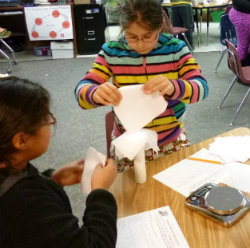Before You Lead That STEM Lesson…
A MiddleWeb Blog

As you get ready to engage students in exciting STEM lessons, be sure to keep these five STEM lesson principles upfront and personal.
1. Know the content and big ideas for the lesson.

Math teachers designing STEM lessons often need to dig deeper into the science content, and science teachers need to understand the grade-level math components. The best possible learning method is for math and science teachers to study and learn together with a STEM lesson in mind. Ongoing collaboration will also help those new teaching practices to stick over time.
2. Keep it real.
The integrated STEM learning approach focuses on combining knowledge from science, technology, engineering and mathematics to solve real-world problems. Suppose you encounter a lesson that involves kids in solving an insect infestation problem involving imaginary insects. Insect infestation may a real problem, but an infestation of mythical insects is not real. This isn’t a STEM lesson.
In my science classes I sometimes used imaginary creatures to generate interest. When studying the rock cycle, my students drew a comic strip about the life story of Sandy Sediment – a mythical grain of sand. But I was not leading a STEM lesson. In STEM lessons the problems and issues being addressed are real ones. Mythical insects and imaginary life forms are not real 21st Century problems (at least, as far as I know). So your STEM lesson should avoid imaginary problems and characters.
3. Understand the role of criteria and constraints in your STEM lesson.

Criteria example: In one lesson teams designed model clot catchers to prevent blood clots from traveling to the lungs. Their clot catchers had to meet four criteria: (1) Catch model blood clots and hold them; (2) stay in place in the model vein; (3) stay together in one piece; (4) allow the blood to keep flowing. Teams used a rubric to evaluate their clot catchers according to the criteria.
Constraints refer to limitations that teams must observe when designing solutions. For example they may have to limit its size or weight. They may have to consider safety factors or environmental impact. One constraint they generally have is the availability of materials. Prepare to help students clearly understand the role of criteria and constraints as they design.
4. Be thoroughly comfortable with the Engineering Design Process (EDP).
I’ve mentioned the EDP in previous posts, but the EDP is truly the heart of your STEM lesson. Let’s do a quick review of EDP steps I use with middle schoolers. These steps don’t have to occur in any particular order. Engineers regularly go back and forth between steps when working on solutions.
Define the Problem: This is the specific engineering challenge that students will address. In this step, the students identify and clarify the problem.
Research: Team members gather needed information about the problem from written material, hands-on investigations, videos, interviews, and in a number of different ways.

Choose and Plan: Team members choose the idea they think will work best and plan how they will design their prototype. They make a specific design plan and sketch. If they have trouble reaching consensus, they use teamwork skills such as active listening, respect, and trade-offs.
Create: Team members build their prototype. All team members play an active role and share responsibilities.
Test and Evaluate: Teams test their prototypes to determine how well they solve the problem. They evaluate them based on how successful they were in meeting the criteria. It’s okay if the prototype doesn’t work because team members can learn from this and correct their design problems in the next version they construct.
Communicate: Team members share specifics about the problem, their designed solution, and the results. They can do this in a variety of ways, including written communication, speech and drama, digital tools, photographs, or other methods.
Redesign: Teams decide how to improve their prototype and redesign it. Team members may synthesize information from their test results and those of other teams to help them decide how to improve their device. This may occur at several stages during the lesson.
5. Know how to teach a STEM lesson.

Students’ work is hands-on and collaborative, and decisions about solutions are student-generated. During the lesson team members make careful observations, develop prototypes, synthesize data, and make informed decisions to guide their redesign. These are not traditional teacher-driven practices: they are student-centered, inquiry-based practices.
On your mark…
So with those basics in mind, get ready to tackle leading STEM lessons. And remember, don’t be afraid of what you don’t know. You do not need to enter the STEM education world as an expert in all things STEM. You just need to be a keen observer, a good learner, and a teacher who knows what the students need to gain from STEM lessons.































As a physics teacher, I like to add that the solution must stem ( no pun intended) from predictions based on scientific priniciples rather than a guess and check. I think this is included in your research phase. As a former nuclear engineer I tell my students that nuclear reactors are not designed on a guess and check basis. The redesign aspect then takes into account all the messy ill defined factors that are not included in the simple ideal scientific case.
That’s certainly an important point! When kids brainstorm solutions their ideas must be informed by those scientific principles they’ve learned/researched. I certainly approve of those nuclear reactors that are based on informed scientific principles.
It is STEM not S&M! You missed the fact that the teachers that are fully trained in technology and engineering have a Technology Education Certificate. Time you include them In your advice on STEM Lessons!
Perceptive and true, Harold. Guilty as charged. I gave technology the short shrift all the way around in this post – focusing primarily on the SEM part. I’ve posted several other posts that focus more on the technology aspect. Not many middle schools I’ve worked with have tech ed teachers. That would be a dream come true – someone for the science and math teachers to collaborate with so that they can integrate technology in truly meaningful ways. Are you a tech ed teacher by any chance?
We don’t expect commenters will read all of our STEM by Design posts (there are 90 to date). But we will note that many of them address technology issues. Several of Anne’s pertinent posts include:
► “Here are some connections I unearthed between CTE programs and STEM projects.”
http://www.middleweb.com/20675/where-career-tech-meets-stem-education/
► “Technology should be presented as more than computers; technology includes all tools used to make life easier and better.”
http://www.middleweb.com/13942/engineer-great-middle-school-stem-curriculum/
► In this fall 2014 post, Anne identified technology integration (and support for technology resources) as one of the top five STEM issues.
http://www.middleweb.com/17350/five-hot-topics-stem-issues/
And — keep in mind that technology can also be the solution to the human need or want proposed in a STEM challenge. In education we often automatically think of informational instructional devices, e.g., multi-media tools, or computational tools, e.g., spreadsheets, calculators, as the T in STEM lessons. I see the T as much broader than that.
Thank you for this article. I am a 5th grade math and science teacher. We are beginning to move in the direction of STEM at my school and we have been working to implement more STEM lessons and units. The breakdown you provided her is a great resource.
Thanks, Krista, and good luck with your STEM lessons. Check around this website and you’ll find several additional posts on STEM lessons and how to write them.
Great article. I’m a 7th grade language arts teacher & I’m required to teach 4 STEM lessons a year – which is a struggle (I’ve got the informational reading & reflectional writing part, technology research, but the Science content is a challenge). Suggestions, resources, recommendations? Thanks!
Hi, Pam – when I design a STEM lesson, I start by looking at what kids are learning in science during a particular quarter, and then find a real world problem in that area that needs to be addressed. 7th grade science often focuses on the life sciences. So maybe having teams of students design a device that can help someone in a wheelchair pick up an object from the floor is a good topic. Clean water is an increasing health problem so what kinds of solutions and prototypes might kids come up with for purifying water? Your first step will be to identify a real problem for kids to address, and sometimes the kids can help with that. go to http://www.egfi-k12.org/ for some ideas and lessons.
The language arts piece would then flow naturally from what the kids need to be able to communicate through briefs, technical writing, etc.
As a language arts teacher you’ve been handed a unusual challenge, indeed! Integrating science, math, and technology using an engineering design process is going to be an interesting task for you. Now is the time to collaborate with your science and math colleagues, see what the students are learning and let them help you put the application in place. (Remember, you don’t have to teach that content – the science and math teacher should be doing that. Your STEM project will help teams of students apply that content to solve a problem.)
Some schools approach STEM as if it’s PBL. Do you think that may be what your school is actually asking you to do – teach PBL? There are definite similarities between the two.
Good luck!
Well STEM lessons but we are required to complete 4 PBLs within the 4 STEM lessons (if that makes sense?)!
Perhaps that means teach lessons where all subjects play a role, but the focus is a real-world engineering problem? Not sure . . . but I wish you well! Keep us posted on how it goes.